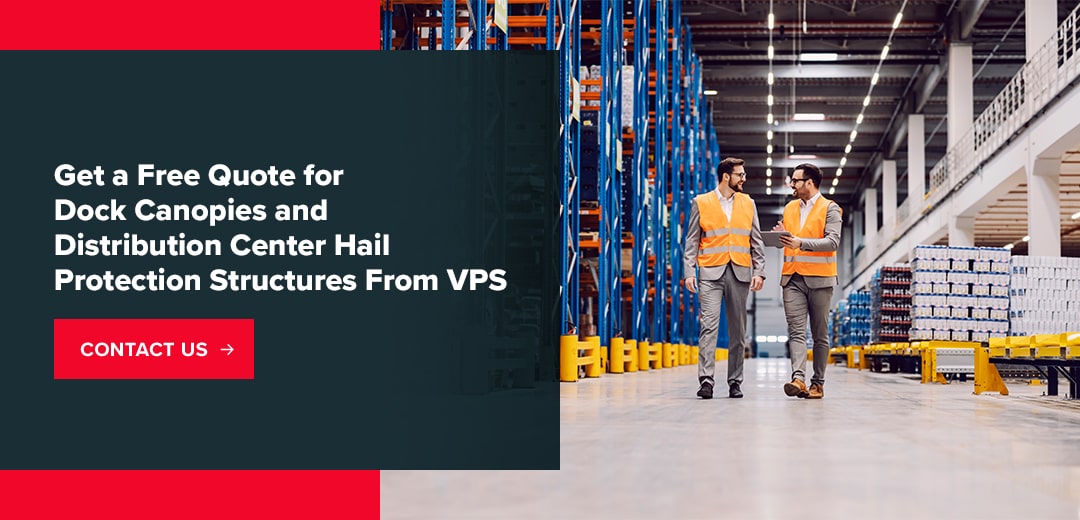How to Improve Your Warehouse Operations
07.07.22

Manager concerns about how to operate a warehouse effectively are common, especially with increased demand for distribution centers. Optimizing processes in a warehouse may increase the potential profit from a site without purchasing additional real estate or hiring more workers. Upgrading structures in and around the warehouse may also improve the facility’s efficiency by adding more storage and lowering the risk to people and products around the facility.
Read the full article or skip to a specific section:
- Importance of Warehouse Operation Efficiency
- How to Organize an Effective Warehouse
- 10 Tips for Effectively Managing Warehouse Distribution
- Benefits of Dock Canopies for Businesses
- Get a Free Quote for Dock Canopies and Distribution Center Hail Protection Structures From VPS
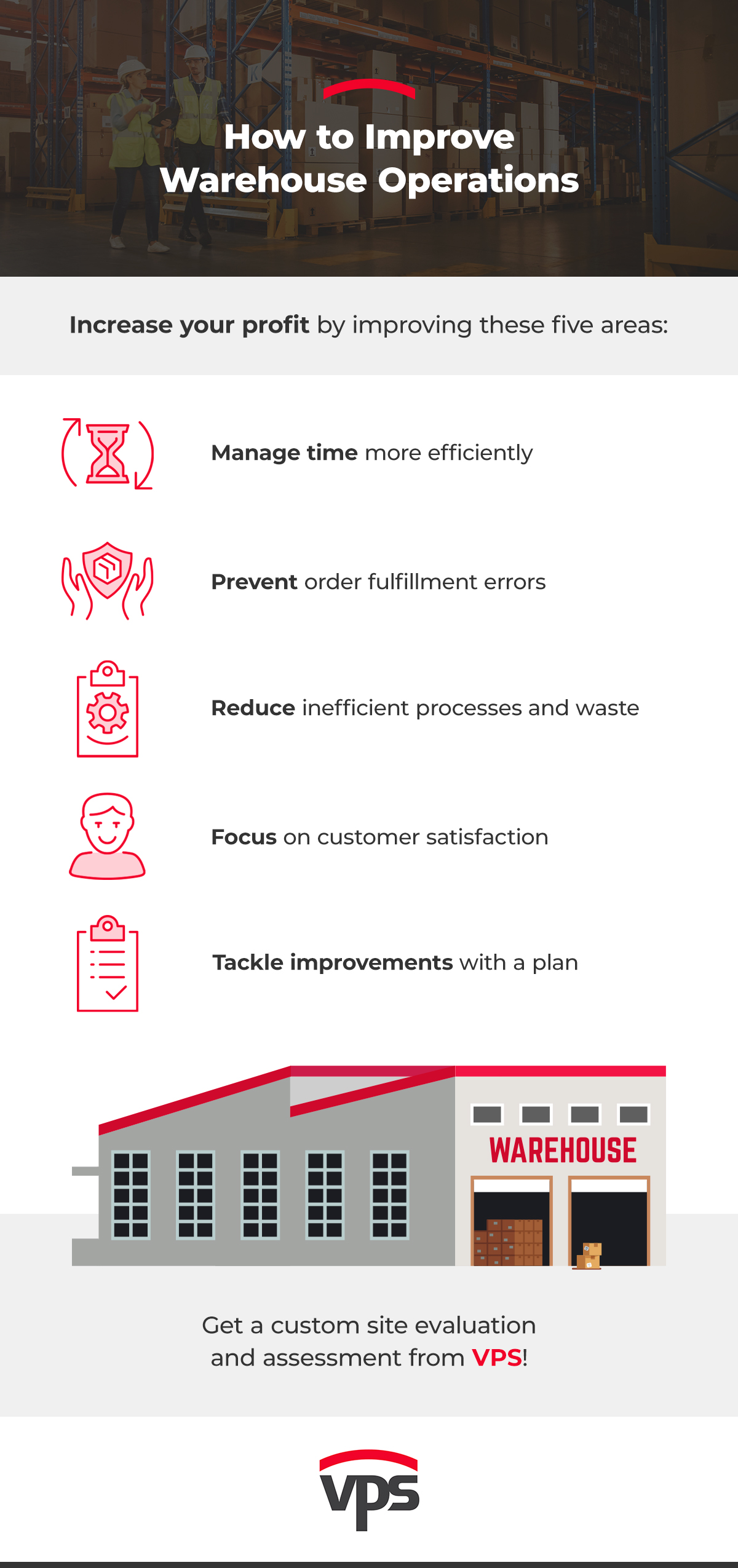
Importance of Warehouse Operation Efficiency
Efficient warehouse operations are a critical part of a healthy supply chain. The first steps are knowing how to run an efficient warehouse and creating a plan to do so. Identifying areas for improvement and creating a plan for the required changes let warehouse managers make the most of a facility’s potential. Once the plan is in effect, the facility can begin to see the rewards of smoother operations.
The perks of an effective warehouse include better time management, reduced waste, and improved customer satisfaction.
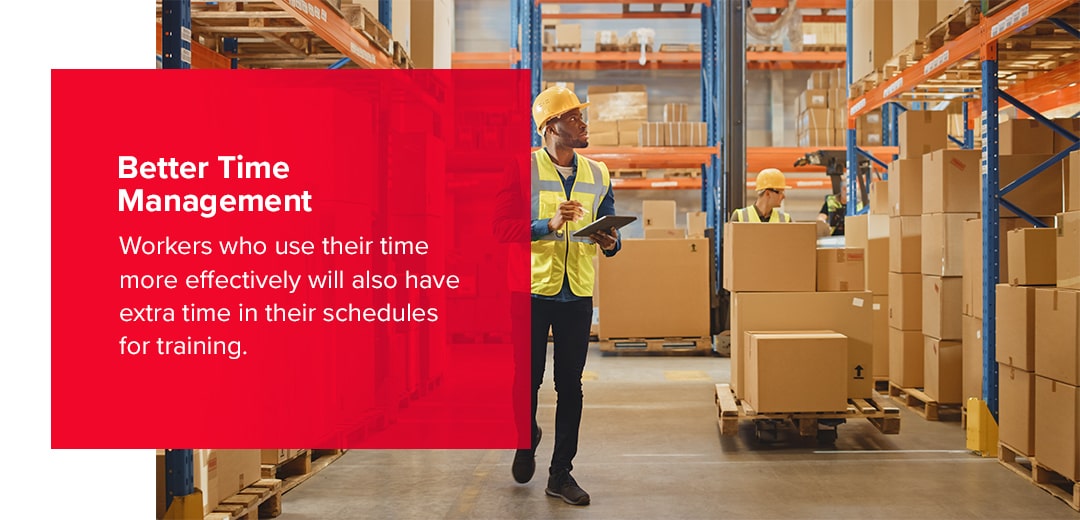
Better Time Management
Efficient warehouses get more done in less time. Workers who make the most of their time can fulfill more orders and reduce delays in shipping. With better time management, on-time deliveries and customer satisfaction can both increase.
Greater efficiency means workers can get more done with the time they have. Less wasted time may reduce the need for the costly process of acquiring and training new employees.
Workers who use their time more effectively will also have extra time in their schedules for training. Education sessions can cover new safety protocols or offer tips for improving order picking strategies. Continuing education for all workers keeps them aware of safety rules, changes in processes, and how they can improve at their jobs.
Prevent Order Fulfillment Errors
Efficient warehouses have methods in place to prevent errors from reaching the customer. Barcode readers verify that the worker picked the correct product from the shelf, helping to prevent human errors caused by misreading labels or accidentally pulling the wrong item.
Preventing order errors saves the time and resources the facility would otherwise spend fixing the mistakes. Workers with greater order fulfillment can spend less time returning products to shelves and going back into the storage area to get the correct product.
Reduce Waste
Efficient warehouses prevent waste and profit losses from missing, damaged, or expired products. Inefficient operations may result in reshelving products in the wrong locations, making them difficult to find again. These misplaced items may add to inventory losses, which cut into profits.
Poorly run warehouses may hold products for too long or in incorrect conditions. For example, an inefficient facility leaves products with a temperature maximum sitting in the sun at the docking area. As the products exceed their recommended temperature, the degradation and damage to the goods cause product loss. Good organization and efficiency reduce the chances that products stay beyond their expiration dates or become damaged from poor storage conditions.
Improve Customer Satisfaction
Customers who receive accurate orders on time will generally feel greater satisfaction with their experience than those whose orders are late or incorrect. Satisfaction is especially important for distribution centers, which provide an essential service within the supply chain by keeping products moving from production to buyers. With satisfied customers, distribution centers can keep their existing customers and possibly expand to serve more.
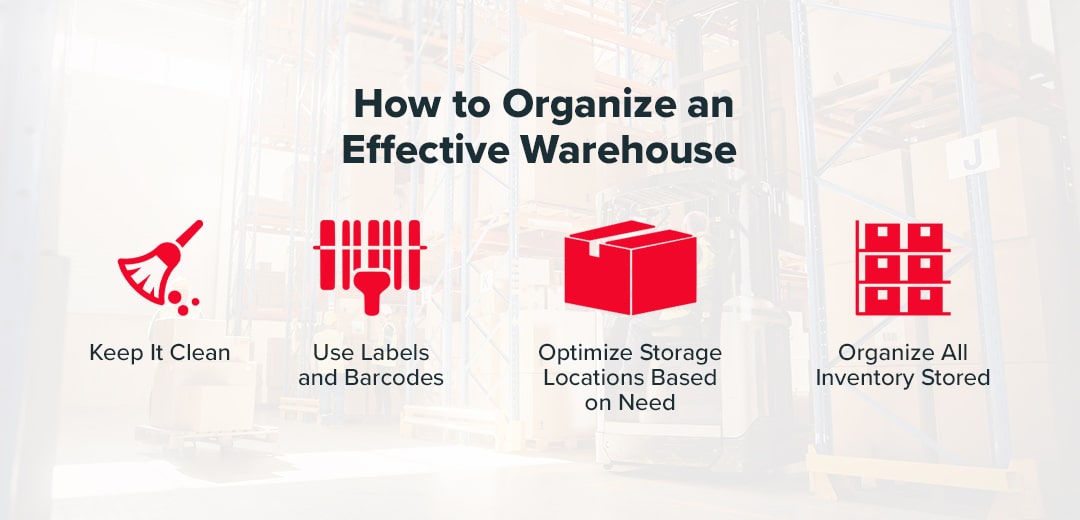
How to Organize an Effective Warehouse
Effective warehouses use their time wisely and minimize errors in order processing. Creating an effective facility means prioritizing organization to allow workers to move safely and quickly through the space when picking, sorting, storing, or packing orders. Maintaining cleanliness, using barcodes and labels, optimizing storage, and being deliberate with inventory storage locations can all help improve a facility’s efficiency and effectiveness.
1. Keep It Clean
Organization starts with a clear, clean warehouse layout. Receiving areas need a designated spot for the disposal, reuse, or recycling of any boxes, pallets, or other containers. Similarly, shipping needs specific locations for any trash from packaging orders to prevent it from accumulating on the ground, as trash on the ground may cause tripping hazards or damage facility vehicles.
Rather than letting unsorted products accumulate, designate time once or twice a week for workers to return any misplaced items to their correct locations. This cleaning task improves efficiency by making products easier to find on shelves, reducing picking time.
2. Use Labels and Barcodes
Labels and barcodes can improve efficiency by reducing order picking time. Labels with locations for product categories can help workers find items faster, and labels on individual bins or rack spots let them verify they have the correct item.
Using barcode scanning along with labels can significantly reduce the chances of order picking errors. After workers use the labels to locate an item, the barcode reader will let them verify that they have the correct product.
3. Optimize Storage Locations Based on Need
A warehouse’s layout should reflect the popularity of the products it houses. Place goods that move fastest in positions closer to the shipping area so that workers can pick them up quickly. Products that sell less often, including seasonal items, can have positions toward the back or higher on racks. Organizing products with this method optimizes picking times and reduces worker travel for most orders.
4. Organize All Inventory Stored
Keeping a well-organized warehouse and using a warehouse management system to help with picking can help reduce wasted time when fulfilling orders.
Whether it’s the most frequently sold products or items with lower demand, all inventory needs a storage spot that will make sense to workers. Classify all products and group them based on sales speed, type, size, and weight to improve the warehouse’s layout and efficiency.
Warehouse management software includes a record of where all goods in the warehouse are located. The software can use this information to create picking recommendations for workers to retrieve products quickly.
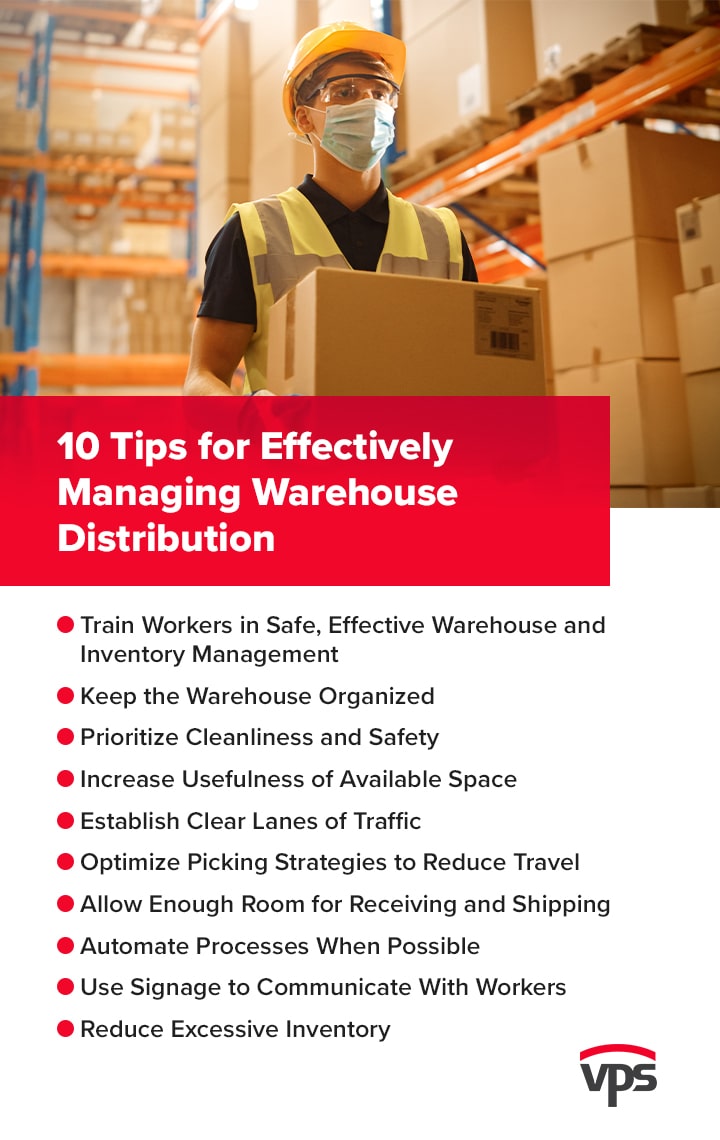
10 Tips for Effectively Managing Warehouse Distribution
Managing an effective warehouse requires a layout and procedures that let workers use their time efficiently while staying as safe as possible. Safety, cleanliness, good organization, and better design all contribute to a highly efficient warehouse, minimizing waste and picking times while maximizing order fulfillment volume and accuracy.
1. Train Workers in Safe, Effective Warehouse and Inventory Management
Workers are the backbone of warehouse operations. They need thorough training in safety procedures and any inventory management systems to support the facility properly. Training in the picking process and using equipment can help prevent human errors in order fulfillment.
Well-trained workers are familiar with the processes and equipment that help keep track of inventory, such as labels or barcode readers. Effective training must continue after the workers’ initial onboarding education. Constant training on best picking practices gives workers the opportunity to continually improve their methods and accuracy.
2. Keep the Warehouse Organized
As with many strategies for effective warehouse management, the goal of organization is to reduce errors and picking times. Keeping a facility well-organized includes having systems in place to prevent products from accumulating outside of their designated spots on the shelves. Designate a space for newly received goods awaiting a permanent location and products that need reshelving due to order picking errors.
Quickly getting goods in their proper places ensures that workers can find what they need as soon as possible. Well-organized facilities also make locating items easier for contractors and temporary laborers who may need to supplement staff during busy times. Careful organization lets these new workers navigate the warehouse and find products quickly.
3. Prioritize Cleanliness and Safety
The top five causes of injury cost the warehousing and transportation industry over $3.91 billion annually. Improved training and safety protocols can help reduce injuries, save money, and prevent lost time by making the site safer. Formulate a culture of safety within the warehouse through training and reminders of safe operations to keep workers thinking about how to work safely throughout their shifts.
Cleanliness is a crucial part of warehouse safety. Spills, narrow aisles, and clutter create hazards in the workplace that may lead to falls and injuries. Workers can improve safety conditions and keep the warehouse functioning efficiently by being diligent about:
- Keeping aisles clean and open.
- Replacing items after using them.
- Cleaning spills quickly.
4. Increase Usefulness of Available Space
Distribution centers are experiencing a surge in demand due to e-commerce practices. The most common fulfillment option for online orders is to ship them directly to the customer from a distribution center. This option is predicted to account for 46% of online orders within the next two years, showing a rising need to optimize space for distribution centers.
While the average capacity use for warehouses in 2022 was 66%, many facilities that used more than half their space had a capacity level average of 78%. These statistics indicate that warehouses need to make the most of their useable space.
If a warehouse is already using most of its floor area, installing vertical storage can increase the available space. Use the higher storage spots for rarely moved or seasonally distributed items. Finding new space by improving organization and adding more racking or shelves lets a facility expand its product storage without buying more real estate.
5. Establish Clear Lanes of Traffic
Create clear lanes of traffic that allow enough space for people and lift trucks to move without crossing paths. Keeping the aisles and lanes open and labeled allows the most efficient movement through the facility. Depending on the aisle space, consider creating one-way traffic lanes to help prevent accidents between pedestrians and warehouse vehicles.
Outline clear traffic lanes with floor markings to show the direction of travel and separate vehicle and pedestrian lanes. Preventing collisions in the warehouse that may lead to injuries can help the facility operate more efficiently.
6. Optimize Picking Strategies to Reduce Travel
Minimize the time and energy workers will need to spend picking products from around the warehouse for a single order. Batch runs involve picking similar items from the same warehouse area and bringing them to a central location. Workers can separate the items into individual orders at this location, making the packing process more efficient.
It takes less time for one person to gather ten units of one item than for ten workers to retrieve a unit individually. Trolleys let a single worker collect batch items from one warehouse area to deliver to the packing area, reducing the total time and improving picking times.
7. Allow Enough Room for Receiving and Shipping
Receiving needs a large warehouse area to organize products, break down boxes, and count goods to input into the warehouse inventory. Similarly, shipping needs a dedicated space for weighing, labeling, and sorting orders.
With enough space for shipping and receiving, these tasks don’t take up valuable space elsewhere in the warehouse. Having enough room for each step in the process also helps workers in these areas stay more organized and efficient.
8. Automate Processes When Possible
Automating tedious processes can save time and reduce errors. Conveyor belts can deliver products to the packing department instead of individuals walking to pull them from the shelves. Barcode readers can verify that a worker picked the correct products without another person manually checking the order.
Inventory management software can help reduce the number of tedious manual counts of warehouse products. The software calculates how many products come in and go out, updating the inventory based on those numbers. Cycle counting groups of stock at regular intervals verifies the software’s accuracy without counting every item in the warehouse.
Software with order sequencing gives workers the most efficient way to pick products for an order, helping reduce wasted steps and time. Order sequencing can also use zones to group order components for picking.
9. Use Signage to Communicate With Workers
Signage around the warehouse communicates essential information for keeping operations efficient. Even new workers or temporary staff can quickly learn the warehouse layout by looking for posted signs showing locations for product categories, storage zones, and traffic flow patterns. The signs can help these workers match the warehouse’s existing efficiency level as they learn their way around.
10. Reduce Excessive Inventory
Stocking goods that don’t move only takes up valuable space. Reducing inventory to only those products that sell will free up space for faster-moving products. Inventory management software and good record-keeping can quickly show which products move and which need downsizing from the facility.
An even more radical option is choosing lean storage practices. With a lean inventory, the facility only keeps products that sell quickly. While this practice requires careful coordination with suppliers and shippers, having fewer items on hand reduces the space needed, makes picking faster, and improves order fulfillment times.
Benefits of Dock Canopies for Businesses
Dock canopies may be profitable additions to a distribution center. They protect the space from sun and hail with various covering options depending on the space available, environmental protection needs, and financial constraints. With sizes to fit walkways or docking areas, canopies can improve safety and comfort and prevent product losses by protecting products from hail or UV damage, helping maintain warehouse efficiency and profitability.
Create a Return on Investment
Depending on location, these structures may qualify the business for tax credits or points toward LEED certification. Solar hail protection can also reduce utility bills and offer long-term protection for the dock area.
Solar hail protection structures add protection from hail damage and may provide a return on the initial investment through electricity savings. Shading the area near open dock bays can keep the sun’s heat from directly shining into the doorway and heating the area inside, reducing cooling costs.
Protect Products and Shipping Vehicles from the Elements
Products and shipping vehicles at the dock need protection from the sun, snow, and hail. Mass coverage structures can fit docking area dimensions from large to small. The mass coverage structures from VPS are the industry’s only option rated for snow loads of 30psf and above. Covering the docking area helps protect shipping trucks, lift trucks, and products left out during loading or unloading from UV rays, hail, or heavy snow.
Another option for covering docking areas is installing cantilevered structures. These covers offer hail and sun protection with a central support column instead of traditional supports at the edges. With fewer columns, cantilevers offer coverage while maximizing the space beneath them for maneuvering shipping vehicles in the dock area.
Improved Comfort and Safety for Workers
Workers experience cooler temperatures when protected from direct sunlight around docking areas. Covered walkways are another way to protect workers on the job as they move outside. Shady working areas may reduce fatigue caused by excessive exposure to the heat and sun during work.
Covering walking paths also keeps hail off sidewalks, reducing the risk to workers by preventing hailstones from falling onto the walkway. While workers should always remain alert to all workplace hazards, including slippery walkways, preventing wet sidewalks may reduce slip-and-fall accidents.
Get a Free Quote for Dock Canopies and Distribution Center Hail Protection Structures From VPS
Avoid the potential loss of products and damage to distribution vehicles caused by sun, heat, rain, or hail. VPS dock canopies and hail protection structures can help provide protection against the elements.
VPS is an experienced leader in the industry. We deliver the solar and hail protection our clients require with high-quality materials like high-density polyethylene mesh (HDPE), which blocks up to 96% of ultraviolet rays. Contact VPS for a free quote for custom dock canopies or hail protection structures.
